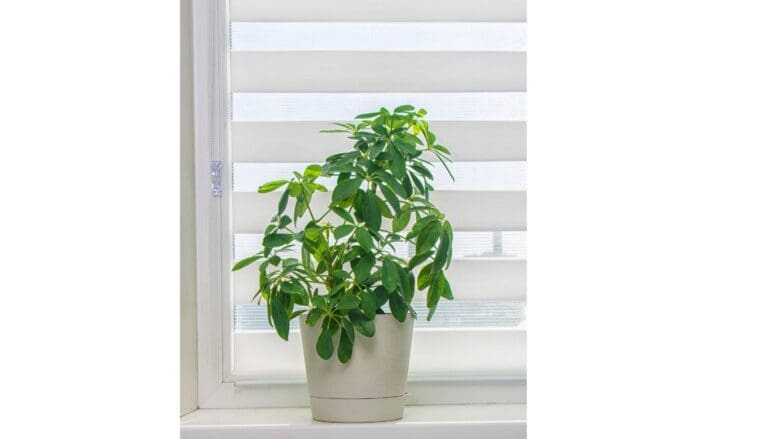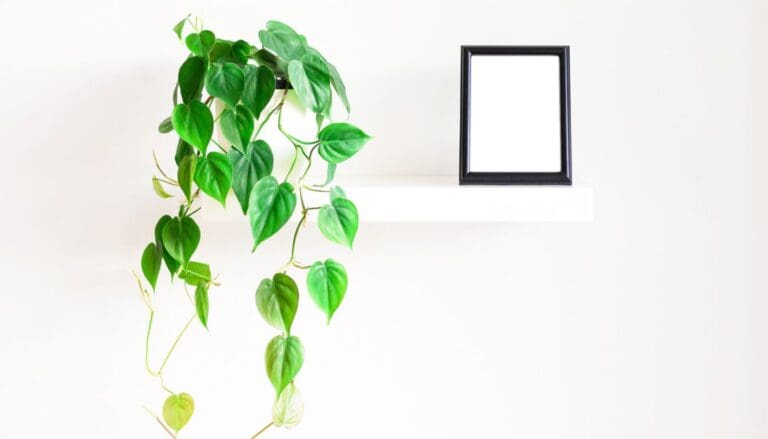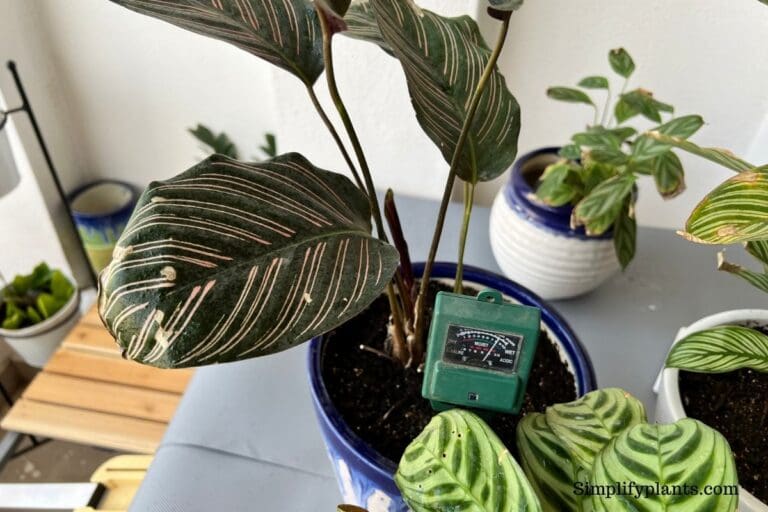Do Pothos Like Coffee Grounds? (What You Need To Be Aware Of)
Coffee grounds have gained attention as houseplant enthusiasts find natural ways to care for their Pothos and keep them healthy.
Coffee grounds are an excellent fertilizer for Pothos. However, there have been several opinions about whether Pothos likes them. While some Pothos lovers use them often, others beg to differ and caution against them because of their high acidity.
In my 12 years of gardening experience, I have used several types of fertilizers for Pothos, and coffee grounds are one of them. Are you curious about whether Pothos likes coffee grounds? Read on to learn more about the benefits and methods of using coffee grounds for Pothos.

Please note: Simplify Plants is reader-supported. Some links in the post are affiliate links and I get a commission from purchases made through links in the post.
Do Pothos like coffee grounds?
Coffee grounds have important nutrients that help Pothos grow well.
Coffee grounds can regulate soil temperature and balance the pH in Pothos potting mix.
Studies indicate that coffee grounds have 2% nitrogen, which is good for Pothos.
Pothos prefers slightly acidic soil, and adding fresh coffee grounds can increase the acidity and improve the plant’s development.
When Pothos ever suffers from deficiency and grows thin stems with small leaves, adding some used coffee grounds can provide the essential nutrients.
Therefore, Pothos like coffee grounds.
Benefits of Coffee Grounds for Pothos
Learn a few more benefits to understand why Pothos like coffee grounds:
- Spent coffee grounds provide several macro and micronutrients and help Pothos’s overall growth and development.
- Coffee grounds act as animal and pest deterrents because their aggressive smell is unbearable.
- Coffee grounds can moderate the Pothos soil temperature and help retain moisture. This way, you don’t have to water your plant too often, thus reducing the risk of overwatering or dehydration.
- Coffee grounds can produce humic substances that enhance Pothos soil’s fertility and structure.
- Besides being an excellent nitrogen source, used coffee grounds can increase the mineral content, like copper, potassium, magnesium, and phosphorus, up to 35% in Pothos.
- Fresh coffee grounds are acidic. It can help adjust the pH level and increase the soil acidity for Pothos.
- Coffee grounds can attract microbes and earthworms that help easily absorb nutrients and improve aeration.
Pothos-specific considerations before using coffee grounds
Whenever my readers ask me about using coffee grounds for Pothos, I suggest they do a few things before using them to avoid potential harm.
Below are the things to consider:
Pothos soil acidity test before applying coffee grounds
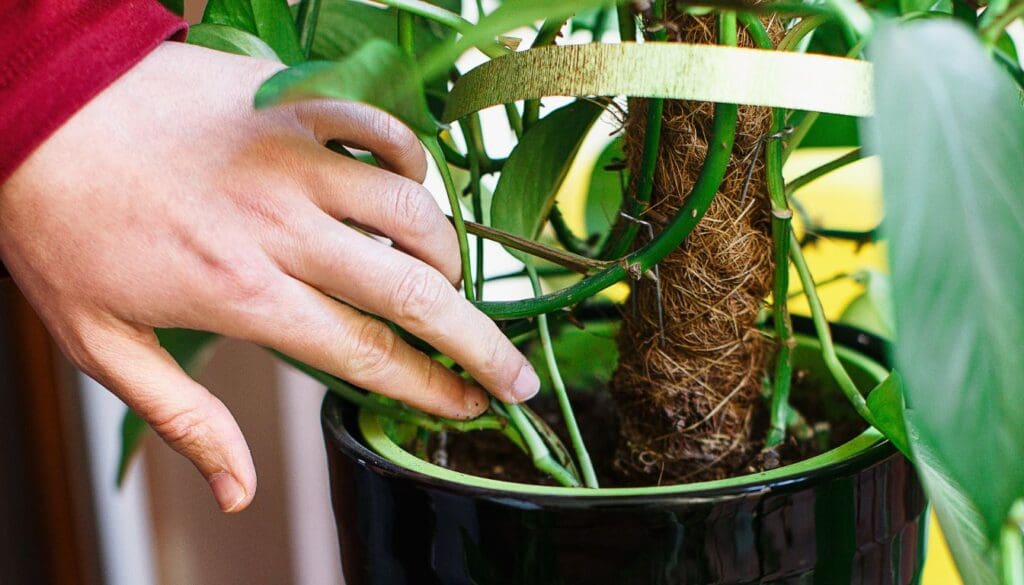
Before applying coffee grounds, check the soil acidity of your Pothos plants.
Fresh coffee grounds are acidic.
If your soil is already acidic, adding more grounds can increase the acidity and harm your Pothos.
To check the soil acidity:
- Take a sample of the Pothos potting mix.
- Place the soil in a small container with ½ cup water and ½ cup baking soda.
- Mix all the ingredients and observe the reaction.
If the mixture begins bubbling, the soil is acidic.
Baking soda is alkaline, and the soil’s acidity reacts by bubbling or fizzing.
In that case, you don’t need to add coffee grounds to your Pothos potting soil.
How much coffee grounds should you use in Pothos?
Understanding the right amount of coffee grounds for Pothos before using is necessary. Less can be fine, but more is harmful.
It depends on your plant’s condition and size, pot size, and soil composition.
Generally, you can apply 1-2 tablespoons or ½ inch of coffee grounds per cup of soil.
Mixing them with the soil for an even distribution is better.
Layer it with 4 inches of mulch.
It will maintain suitable soil pH and provide the necessary nutrients.
For your soil mix, use 20% coffee grounds if you know how much compost you need.
The application method also affects the quantity of coffee grounds needed for Pothos. We will discuss it later.
How often do you apply coffee grounds to Pothos?
The application frequency of coffee grounds for Pothos is very crucial.
It depends on the plant’s growth rate, pot size, and soil nutrient levels.
Coffee grounds work as a slow-release fertilizer and hence release the nutrients slowly.
Use it every 2-3 months during the growing season.
Check your Pothos often after applying coffee grounds to notice its behavior and adjust it with the application frequency.
Different ways to use coffee grounds for Pothos

There are several ways to use coffee grounds for Pothos.
Besides different application methods, you will also learn the quantity needed for each method.
Below are some ways I have used coffee grounds for my Pothos:
Coffee grounds as an organic fertilizer
Sprinkle 1-2 tablespoons of coffee grounds on the soil surface of Pothos.
Water thoroughly for even distribution of the nutrients.
Another method is to mix them with the top layer of the potting soil instead of sprinkling.
It will act as a slow-release fertilizer and add essential nutrients to the soil.
Be careful while using this method, as coffee grounds can retain moisture for a long, leading to sensitive issues like overwatering or root rot.
You should adjust the watering schedule to overcome the issue.
Coffee grounds as mulch
Add a ½-inch layer of coffee grounds on the soil for your Pothos plant.
Next, add around 4 inches of the organic mulch (leaf mold and compost) you have prepared for Pothos.
You can also mix the coffee grounds with organic mulch and then apply the mulch around your Pothos.
Incorporate coffee grounds with the soil
Mix 10-20% of coffee grounds with the potting mix of your Pothos with other organic matter while repotting.
The addition will enhance the nutrient content of the soil and provide your Pothos with all the essential nutrients.
Coffee grounds in composting
Mix 20% of coffee grounds in a compost pile you have made for your Pothos.
With this method, it ensures that the nutrients get used fully.
You can also use coffee filters.
Earthworms love feeding on the coffee and coffee filters.
It makes your compost more nutritious.

Use coffee grounds as compost tea
Make a compost tea with used coffee grounds, and water your Pothos with it.
Fill a bucket with 5 gallons of water, add 2 cups of coffee grounds, mix well, and let the solution stand overnight.
Strain the liquid and use it as a liquid fertilizer.
Water your Pothos the next day with the solution.
Use the solution within 48 hours of using the coffee grounds for maximum nutrient benefit.
Make sure the water reaches the roots.
You can poke some holes with a fork or chopstick to let the water seep through and reach the soil.
Another method of making compost tea with coffee grounds is by stacking the grounds into a sock.
Put the sock inside a 5-gallon bucket filled with water.
Let it seep for a few days, and then you can water your Pothos.
Coffee grounds and their impact on Pothos
Despite the benefits, there are some potential dangers of using coffee grounds in Pothos.
Here are a few negative impacts of coffee grounds on Pothos:
- Coffee grounds retain moisture for prolonged periods, promoting excessive moisture and fungal growth. You can prevent this by setting a proper watering routine and often checking the soil moisture before watering.
- Coffee grounds make obstructions just like clay soil. When it dries, it becomes hard and inhibits good drainage.
- Excessive coffee grounds can also harm both young and mature Pothos, as too much caffeine can suppress root growth. While you can still use it, please don’t overdo it.
- Coffee grounds work as an antibacterial. Hence, they might kill the good bacteria as well.
- Coffee grounds increase microorganism growth. These microorganisms use nitrogen for their growth, leaving nothing for your Pothos.
- Since fresh coffee grounds are acidic, excessive use can increase the soil acidity and harm your Pothos plant.
- Though coffee grounds can keep pets away from Pothos, some curious pets, like dogs, might nibble. Coffee is toxic to animals.
Additional things to keep in mind while using coffee grounds for Pothos
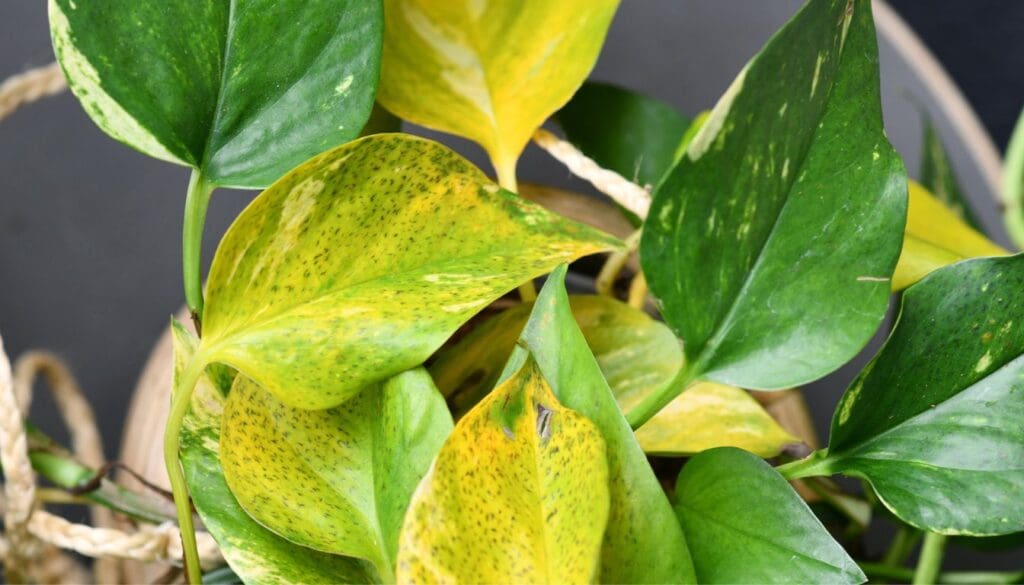
Despite the drawbacks, you can use coffee grounds for Pothos with moderation and care.
Here are a few more things I suggest my readers while using coffee:
- Use thin layers of coffee grounds on the Pothos’s soil surface or make compost tea out of it.
- Mix spent coffee grounds in a compost pile or potting soil mix to easily break down the nutrients and reduce the risks associated with coffee grounds.
- If you use fresh coffee grounds, dilute them with water or mix them with compost or potting mix. Make sure the soil acidity for Pothos is lower because fresh grounds are highly acidic. If not required, use spent grounds.
- Ensure Pothos soil is well-drained because coffee can contribute to compaction.
- If you have multiple Pothos, each of them might respond differently based on their conditions. So, observe every plant closely after coffee ground application. If you notice any weird signs, adjust the amount or frequency accordingly.
Maintenance tips for Pothos with coffee grounds
- Coffee grounds can increase the moisture retention of the Pothos soil. If the soil gets soggy, it can lead to root rot. So, check the soil moisture often and adjust the watering accordingly.
- Despite using coffee grounds, use a general, all-purpose, balanced liquid fertilizer. Coffee grounds will provide adequate nutrients, but additional fertilizer will strengthen your Pothos by providing the nutrients absent in coffee.
- Coffee grounds can lead to fungal growth and mold if used too much. Use them in less amounts.
- Keep the surroundings clean and free from debris. Trim away the dead and damaged leaves, and check your soil often for infestation signs.
- Repot your Pothos every 1-2 years. While repotting, use new, healthy, well-drained soil mix for your Pothos to thrive.
- Ensure your Pothos gets proper light, water, soil, temperature, and humidity to avoid stress.
Alternatives to coffee grounds in Pothos
If coffee grounds are ineffective, or your Pothos always suffers from its usage, you can try other alternatives.
Below are a few more alternatives I use besides coffee:
Compost

Compost can be a great alternative to coffee grounds for Pothos.
It will also provide the required nutrients, improve the soil structure, and retain moisture.
Compost contains beneficial microorganisms and trace minerals ideal for Pothos.
It also has nitrogen in lower concentrations than coffee grounds, which reduces the risk of over-fertilization.
Fish emulsion
Fish emulsion is another great fertilizer option for Pothos as it is made from the fish parts.
It contains nitrogen, phosphorus, potassium, and other minor minerals beneficial for Pothos.
You can use it as an alternative to coffee grounds or with coffee grounds to increase the soil acidity besides adding nutrients.
Kelp meal, blood meal, and bone meal
These fertilizer meals are more environmentally friendly than synthetic or commercial fertilizers.
They are considered to be great for gardeners who want something sustainable.
Worm castings
Worm castings are natural and rich sources of essential nutrients and microorganisms for Pothos.
Worm castings can improve the soil structure and water retention while providing adequate nutrients to the soil.
Eggshells
Crushed eggshells are rich in the essential trace minerals, especially calcium.
You can mix them with the soil for a steady release of calcium, which helps strengthen the cell walls and encourages healthy root and leaf growth.
Another way to use eggshells is to dry and crush the shells, soak them in water for a day, strain the liquid and water Pothos 1-2 times a month.
Seaweed extract
Seaweed extracts provide trace minerals with growth-promoting materials like cytokinins and auxins.
Adding some seaweed extract to the water while watering the Pothos plants.
Commercial fertilizers

Multiple commercial fertilizers are available for Pothos that work better and provide more benefits than coffee grounds.
These are available either in liquid or slow-release granules or pellets.
Pothos required a balanced fertilizer with equal parts of nitrogen (N), phosphorus(P), and potassium (K).
Choose a fertilizer with 10-10-10 or 20-20-20 NPK levels.
Use liquid fertilizers every 4-6 weeks and slow-release 1-2 times a year only during the spring and summer.
Also, ensure that the fertilizer contains micronutrients like calcium, magnesium, manganese, iron, and zinc to benefit Pothos’s overall growth and development.
Final thoughts
Coffee grounds are excellent for Pothos. They are an excellent nitrogen source, have sufficient macronutrients and micronutrients, and beneficial microorganisms to boost Pothos’s overall growth and development. Additionally, coffee grounds can improve soil structure and retention, adjust soil acidity, and keep insects and animals at bay. However, excessive or wrong use can be detrimental to Pothos. Hence, use them in moderation with the correct quantity and frequency.
You can apply coffee grounds in various methods, such as a slow-release fertilizer or mulch, adding to the potting mix or compost pile, or making compost tea. Do not solely depend on coffee grounds for feeding your Pothos. Consider using other organic or commercial fertilizers for sufficient nutrition. If you don’t want to use coffee grounds, use alternatives like compost, fish emulsion, kelp meal, blood meal, bone meal, worm castings, seaweed extract, and eggshells.
Observe Pothos’s reaction after applying coffee grounds and see if it shows any signs of distress, like yellow or brown leaves, wet soil, stunted growth, or defoliation. Adjust the frequency or quantity of coffee application to fix the issue. Don’t use coffee grounds for small or newly propagated Pothos plants.
Can I water my Pothos plants with coffee?
Water your Pothos with cooled coffee, but be careful not to use too much as it can lead to over-fertilization.
How do I adjust the soil pH after using too much coffee grounds?
If you have overused coffee and Pothos soil acidity has increased, use lime to increase soil pH or sulfur to lower it. Stop using grounds again.
Should I use fresh or used coffee grounds for Pothos?
Both are beneficial. Used coffee grounds are already broken down, making nutrient release and absorption easier. Fresh grounds have high acidity levels, which can help adjust the soil acidity for Pothos.
Reference: Used coffee grounds for Pothos, Pothos Wikipedia
Recommended Garden Supplies
| Product Image | Our Recommended Gardening Supplies | Check Offers! |
|---|---|---|
Top Top
Top
Top
Top
Top
Top
Top
Top | rePotme Houseplant and Tropical Classic Potting Soil Mix | Check Offer On Amazon |
 Top
Top
Top
Top
Top
Top
Top
Top | Espoma Organic Indoor Plant Food | Check Offer On Amazon |
 Top
Top
Top
Top
Top
Top
Top
Top | GooingTop LED Grow Light 6000K Full Spectrum Clip Plant Growing Lamp | Check Offer On Amazon |
 Top
Top
Top
Top
Top
Top
Top
Top | Soil Moisture Meter | Check Offer On Amazon |
 Top
Top
Top
Top
Top
Top
Top
Top | Govee Hygrometer Thermometer, Bluetooth Enabled! | Check Offer On Amazon |
 Top
Top | LEVOIT Humidifiers for Large Room(Best For Plants) | Check Offer On Amazon |
 Top
Top
Top
Top
Top
Top
Top
Top | Upgraded DIY Automatic Drip Irrigation Kit, 15 Potted Houseplants Support | Check Offer On Amazon |
 Top
Top
Top
Top
Top
Top
Top
Top | Stainless Steel Heavy Duty Gardening Tool Set | Check Offer On Amazon |
 Top
Top
Top
Top
Top
Top
Top
Top | Bonide Insecticidal Soap | Check Offer On Amazon |
 Top
Top
Top
Top
Top
Top
Top
Top | Bonide 32 oz Spray Neem Oil for Organic Gardening | Check Offer On Amazon |
 Top
Top
Top
Top
Top
Top
Top
Top | Garden Safe Fungicide | Check Offer On Amazon |

